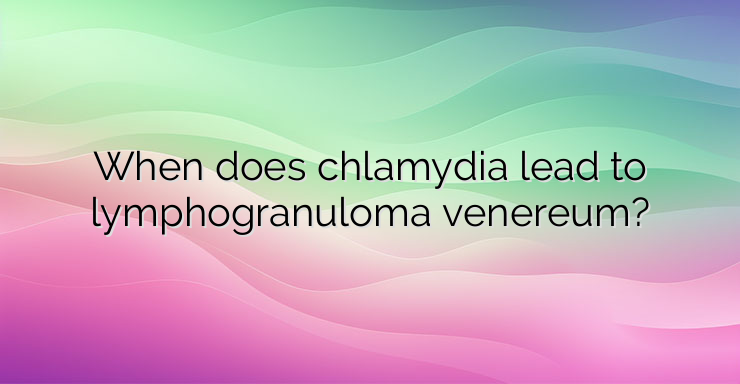What is lymphogranuloma venereum? Lymphogranuloma venereum (LGV), lymphogranuloma venereum, or chlamydial lymphogranuloma is a sexually transmitted disease thought to affect people in the developing world. Unfortunately, it is now on the rise worldwide. Venereal lymphogranuloma is closely related to HIV infection. Also, as with many other STDs, lymphogranuloma venereum can actually increase your risk of contracting HIV. Lymphogranuloma venereum is caused by a species of chlamydia (Chlamydia trachomatis). Many types of chlamydia infect humans. DK serotypes cause standard genital infections. AC serotypes cause trachoma (blindness). Serotypes L1, L2, and L3 cause chlamydial lymphogranuloma. What are the risk factors for developing lymphogranuloma venereum? One of the main risk factors for lymphogranuloma venereum is HIV positivity. Unprotected sex is another key risk factor for lymphogranuloma venereum. The infection can be transmitted during unprotected vaginal and anal sex. Chlamydial lymphogranuloma is diagnosed more in men than in women. What are the symptoms of lymphogranuloma venereum? In some respects, lymphogranuloma venereum is a more similar infection to syphilis than to standard genital chlamydial infection. Like syphilis, symptoms can become systemic (spread throughout the body) rather than remaining in a limited area. Chlamydial lymphogranuloma is also similar to syphilis in that the infection has several stages. The first stage usually occurs within one to two weeks. The second stage is usually between two and six weeks after infection. First stage: A small bump or papule; Skin ulcers are possible Second stage: Enlarged lymph nodes around the groin (less common in women); Fever; Indisposition; Back or pelvic pain; Itching, discharge, and rectal bleeding What are the complications of lymphogranuloma venereum? The third stage or late stage of lymphogranuloma venereum can lead to significant complications. They include: Abscesses (accumulation of pus in a pathologically formed cavity); Fistula (abnormal canal covered with epithelium or granulation tissue); Rectal strictures (narrowing of the rectum); Severe swelling of the genitals; Genital deformity; Pelvic organ dysfunction; Infertility If left untreated, chlamydial lymphogranuloma can become chronic and cause long-term damage to the lymphatic system, just as untreated chlamydia can lead to pelvic inflammatory disease. Problems usually begin to appear approximately five to ten years after the initial infection. How is lymphogranuloma venereum diagnosed? The diagnosis of lymphogranuloma venereum is made based on the physical examination, the history taken (medical history) and information from the patient’s sex life. If lymphogranuloma venereum is suspected, based on the symptoms, tests are prescribed,which may include: Biopsy of swollen lymph nodes; Blood test for lymphogranuloma venereum; Laboratory test for chlamydia Chlamydial lymphogranuloma is often extremely difficult to detect on examination. In order to make a correct diagnosis, doctors must both be familiar with the disease and take a detailed history. Examination of the material from the wounds may not give a clear result. Bacteria may not always be detected, depending on the stage of the disease. Most labs cannot tell the difference between a standard chlamydia infection and Lymphogranuloma venereum. This means that a patient may end up being misdiagnosed with chlamydia rather than lymphogranuloma venereum. If the patient has signs or symptoms involving the rectum that are suspicious for lymphogranuloma venereum, samples may be taken for further testing. What is the treatment for lymphogranuloma venereum? Chlamydial lymphogranuloma is usually treated with the antibiotic doxycycline (100 mg) twice daily for 21 days. According to the Centers for Disease Control and Prevention (CDC), this treatment cures more than 98.5% of cases of the disease. Treatment may be longer in severe cases. Other antibiotic options include azithromycin or erythromycin. The patient should inform his sexual partners about his diagnosis. This means he must inform anyone he has had sex with in the 60 days since the onset of symptoms. That way, they can get treatment before symptoms start or complications from the infection develop. A patient with lymphogranuloma venereum should avoid any sexual activity until treatment is completed. References: 1. Rawla P, Limaiem F. Lymphogranuloma Venereum. Stanford Health Care. LGV 2. Ceovic R, Gulin SJ. Lymphogranuloma venereum: diagnostic and treatment challenges 3. McLean CA, Stoner BP, Workowski KA. “Treatment of lymphogranuloma venereum.” 4. Verywell Health. Lymphogranuloma Venereum Symptoms and TreatmentWhat is the treatment for lymphogranuloma venereum? Chlamydial lymphogranuloma is usually treated with the antibiotic doxycycline (100 mg) twice daily for 21 days. According to the Centers for Disease Control and Prevention (CDC), this treatment cures more than 98.5% of cases of the disease. Treatment may be longer in severe cases. Other antibiotic options include azithromycin or erythromycin. The patient should inform his sexual partners about his diagnosis. This means he must inform anyone he has had sex with in the 60 days since the onset of symptoms. That way, they can get treatment before symptoms start or complications from the infection develop. A patient with lymphogranuloma venereum should avoid any sexual activity until treatment is completed. References: 1. Rawla P, Limaiem F. Lymphogranuloma Venereum. Stanford Health Care. LGV 2. Ceovic R, Gulin SJ. Lymphogranuloma venereum: diagnostic and treatment challenges 3. McLean CA, Stoner BP, Workowski KA. “Treatment of lymphogranuloma venereum.” 4. Verywell Health. Lymphogranuloma Venereum Symptoms and TreatmentWhat is the treatment for lymphogranuloma venereum? Chlamydial lymphogranuloma is usually treated with the antibiotic doxycycline (100 mg) twice daily for 21 days. According to the Centers for Disease Control and Prevention (CDC), this treatment cures more than 98.5% of cases of the disease. Treatment may be longer in severe cases. Other antibiotic options include azithromycin or erythromycin. The patient should inform his sexual partners about his diagnosis. This means he must inform anyone he has had sex with in the 60 days since the onset of symptoms. That way, they can get treatment before symptoms start or complications from the infection develop. A patient with lymphogranuloma venereum should avoid any sexual activity until treatment is completed. References: 1. Rawla P, Limaiem F. Lymphogranuloma Venereum. Stanford Health Care. LGV 2. Ceovic R, Gulin SJ. Lymphogranuloma venereum: diagnostic and treatment challenges 3. McLean CA, Stoner BP, Workowski KA. “Treatment of lymphogranuloma venereum.” 4. Verywell Health. Lymphogranuloma Venereum Symptoms and Treatment


Leave a Reply